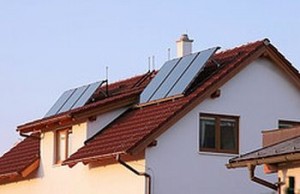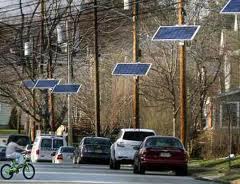 While it’s hard to dispute the fact that getting consistent solar power to American homes and businesses would be a huge boon to our environmental and geopolitical interests, the first major installations are finding opposition at every turn. It’s not that citizens oppose the energy source itself, which circumvents a lot of the drawbacks of fossil-fuel energy; it’s that there doesn’t seem to be any one place in which we can put our solar panels that won’t piss somebody off.
While it’s hard to dispute the fact that getting consistent solar power to American homes and businesses would be a huge boon to our environmental and geopolitical interests, the first major installations are finding opposition at every turn. It’s not that citizens oppose the energy source itself, which circumvents a lot of the drawbacks of fossil-fuel energy; it’s that there doesn’t seem to be any one place in which we can put our solar panels that won’t piss somebody off.
Among American states, the first adopters of the technology on a large scale have been California and New Jersey. California, a state whose longtime Governator Schwarzenegger was (and is) an outspoken proponent of solar energy, has unrivaled potential for solar development. In particular, the Mojave Desert has long been considered an ideal location for a large-scale solar plant: it’s large, very sunny, and more or less empty of human developments. Two years ago, Southern California Edison signed a deal with a company called BrightSource to build a major solar facility in a section of the desert called the Ivanpah Valley. Schwarzenegger recently wrote in The Atlantic that “asking whether large solar power plants are appropriate in the Mojave desert is like wondering whether subways make sense in New York City.”
But the project has been slowed up since then, largely (and perhaps surprisingly) due to the objections of environmental groups. The reason they’re giving is that the Ivanpah Valley is home to about twenty members of a very rare species of tortoise. The small animal, which is protected by the government under the endangered species list, would see the Ivanpah portion of its habitat changed quite drastically by the construction of acres of solar panels. The tortoise is serving a symbolic purpose for the environmental opposition, however: put plainly, they don’t want to see wide chunks of wilderness converted to power production, however green that power may be.
 On the other coast, New Jersey is taking a different tack. Since it doesn’t have the kind of vast, undeveloped space that CA does -- the state has one of the highest population densities in America -- electric producers in the state have instead begun to install a network of small panels attached to utility poles in residential neighborhoods. Across the state, the panels add up to about the equivalent of a 170-acre solar farm. The project is part of the state’s ambitious mandate to get 23% of its electric supply from renewable sources by the year 2021.
On the other coast, New Jersey is taking a different tack. Since it doesn’t have the kind of vast, undeveloped space that CA does -- the state has one of the highest population densities in America -- electric producers in the state have instead begun to install a network of small panels attached to utility poles in residential neighborhoods. Across the state, the panels add up to about the equivalent of a 170-acre solar farm. The project is part of the state’s ambitious mandate to get 23% of its electric supply from renewable sources by the year 2021.
But there, too, we’re seeing controversy over the panels. As a somewhat histrionically worded New York Times article from last week notes, some residents are bothered by the panels because they consider them to be “‘ugly’ or ‘hideous’.” Especially in wealthy communities in Bergen County, there’s backlash against what the article refers to as “the encroaching blight”; residents are pressuring municipal governments to stop or slow the building of the solar infrastructure, in order to “spare their tree-lined streets.” Here, too, no one’s complaining about the panels themselves. (Over at good.is, Ben Jervey rightly notes that this opposition isn’t anything like unanimous -- many residents are willing to accept the panels as a cost of living in an environmentally sound way.) Still, if towns keep putting up roadblocks for the project -- in Ridgewood, for instance, it’s been legally put on hold over a technicality -- it could really put a damper on the growth of residential solar as an energy solution.
To sum up: on the one hand, some residents don’t want us to place solar production where we live; on the other, those areas which we haven’t already developed deserve protection. But doesn’t that rule out every single place that we could position our solar production? Something’s got to give. Is there anywhere in the world where we can agree to build solar infrastructure?
While we continue to debate that question, some scientists have proposed a way to avoid the problem entirely: instead of installing panels in America, let’s get our solar power from space. The science is still being worked out, but California has already signed a deal with a company called Solaren, which is promising to deliver about the equivalent of a large coal factory’s output from an orbiting power station by 2016. If it works, space-based solar has a lot of upside: the energy beyond the atmosphere is undiluted by air, meaning that it could be collected much more efficiently than it would be on the ground. It’s hard to know whether this sci-fi-esque solution will ever become a concrete reality, of course, but as we wait to see what the next step will be for solar, the final frontier is looking pretty appealing.